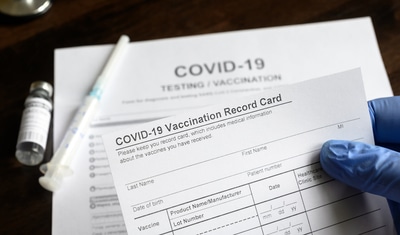By Kathryn (Kamil) Canale
Last week, the Occupational Safety and Health Administration (OSHA) issued a new emergency temporary standard which would soon require all covered employers with 100 or more employees to either require its workforce to receive mandatory vaccinations against COVID-19 or weekly tests. I call it the “Rule.” Almost immediately thereafter, the Fifth Circuit Court of Appeal granted a stay of the Executive Order, thereby staying the Rule. At this juncture, we don’t know when or whether the Rule will go into effect. However, the Rule has deadlines that all employers who must comply with the Rule should be prepared to meet. If you have not read and digested all 490 pages of the Rule yet, not to worry. The most important parts of the Rule are summarized below.
Who Must Comply?
First, you need to determine if the Rule applies to you. Under the OSHA Rule, any employer with 100 or more employees as of November 5, 2021 must comply. Likewise, if you meet or exceed 100 employees at any time after the Rule comes into effect, you must comply. If you drop below 100 employees after you have qualified, you must comply.
Who is counted in determining whether you meet the 100 employee requirement? Pretty much every person on the payroll counts – full time, part time and remote employees. If you have multiple locations with employees (anywhere in the country) totaling over 100, you must comply.
Is Your Company Going to Mandate the Vaccine?
Next, you need to decide if you are going to mandate the COVID-19 vaccine (or alternatively, weekly testing). This is a big question with a lot of pros and cons. It is important to remember that even if you have a mandatory vaccination policy, you must still go through the interactive process with those employees who may be exempt due to a medical or religious reason.
If You Are Required to Comply, By December 6, 2021, You Must:
Have Your Vaccination/COVID-19 Policies in Place. Whether you mandate the vaccine or not, employers must have and implement vaccine and COVID-19 reporting policies. In addition to the vaccination policy itself, your policies should include:
- The process used to determine employee vaccination status;
- The time and pay/leave they are entitled to for vaccinations and any side effects experienced following vaccinations;
- The procedures employees need to follow to provide notice of a positive COVID-19 test or diagnosis of COVID-19 by a licensed healthcare provider;
- The testing procedure for those employees who are not vaccinated (see below);
- Your masking policy; and
- The procedures to be used for requesting records.
Determine if Any of Your Employees are Exempt. The Rule exempts a few employee classifications. These are mostly employees who are 100% remote and have no contact with any other human beings as part of their work day.
Determine Vaccination Status of Your Employees. Obtain acceptable proof of vaccination for each vaccinated employee, maintain those records and create a roster of vaccination status of your employees.
Determine How You Will Complete Mandatory Testing for Unvaccinated Workers. By January 4, 2022, employers who have to comply with the Rule will have to ensure employees who are not fully vaccinated are tested for COVID-19 at least weekly if in the workplace or within 7 days of returning to work. Employers need to make sure employees who are required to undergo weekly testing know when, where and how to undergo testing. While the Rule indicates that the testing cost can be borne by the employee, note that these are federal guidelines – in California, the employer, not the employee, bears the cost of the testing.
Make Sure Employees Who Are Not Fully Vaccinated Wear Face Coverings. While this may not be a big deal in Los Angeles where face coverings are still required in most settings for all employees, it is a big deal in cities and counties where no such mandate currently exists. When in doubt, follow the stricter mandate. OSHA puts the burden on employers to enforce mask compliance.
Educate Your Employees. Not only do you need proper policies and procedures in place to comply with the Rule, but you need to make sure your employees understand and comply with them. This is often easier said than done. The Rule requires employers to communicate its policies and procedures to its employees. This should be done early and often. If English is not an employee’s first language, you should make sure the policies are effectively translated.
Reporting COVID-19 Fatalities and Hospitalizations. Under the Rule, all work-related COVID-19 fatalities and hospitalizations must be reported to OSHA within 24 hours. This is in addition to any local reporting requirements.
What Else You Need To Know.
Vaccination Support. Employers are required to support their employees getting the COVID-19 vaccination by providing employees with a reasonable amount of time during work hours to obtain their primary doses of the vaccine. This includes scheduling, travelling to and from the vaccination site and obtaining the vaccine. OSHA defines a reasonable time as up to four hours of paid time at the employee’s regular rate of pay. This cannot be offset by other leave, such as sick pay or vacation time. Employers are not required to pay employees who get the vaccine outside of working hours.
Time Off for Side Effects. If an employee experiences side effects from the vaccine, employers may require the employee to use their accrued paid sick leave while recovering from side effects experienced following primary vaccine dose(s). Employers cannot require an employee to use vacation time for this purpose. Likewise, employers cannot require employees to use advanced sick leave to cover reasonable time needed to recover from vaccination side effects. In other words, employers cannot require an employee to go into the negative for paid sick leave if the employee does not have accrued paid sick leave when they need to recover from side effects experienced following a vaccination. However, in response to the FAQs, OSHA stated that it “presumes that, if an employer makes available up to two days of paid sick leave per primary vaccination dose for side effects, the employer would be in compliance with this requirement.” This leads us to wonder how many employees will decide to get their vaccinations the Monday afternoon before Thanksgiving – requiring Tuesday and Wednesday off to recover from “side effects.”
Documentation. While mentioned throughout, we can’t stress enough the need for great documentation. This includes keeping each employee’s signed vaccination policy in their respective employee file, maintaining an employee’s vaccination record in yet another file and maintaining the required roster of all employees identifying who is and is not vaccinated. It also includes keeping a copy of every single test result of your employees who are required to undergo weekly testing. The Rule also requires employers to make the aggregate number of fully vaccinated employees at a workplace along with the total number of employees at the workplace available to an employee or their representative upon request.
Enforcement. While OSHA has spelled out hefty fines for failing to comply with the Rule, it remains unclear how OSHA will actually enforce compliance of the Rule. Likely, enforcement will come from whistle blower employees who report non-compliance to OSHA.
Period of Compliance. In its FAQs, OSHA anticipated that the new Rule will be in effect for six months. I am not holding my breath on this one….the pandemic has been going on since March 2020. Who thought then that employers would still be getting new rules and regulations about COVID-19 in November 2021? I know I sure didn’t.
Never fear, help is here.
Even shorted from 490 pages, this is a lot of information to digest. Don’t fret. If you need new policies (or assistance revising your current ones), have questions about compliance, need assistance setting up your documentation procedures or determining whether you even need to comply with the Rule, BG+W is ready to help and is only a phone call away.

Kathryn (Kamil) Canale is a Partner at Bradley, Gmelich & Wellerstein LLP. Kamil is an AV-Preeminent rated trial attorney who has defended clients for more than 20 years in business, employment (employer side) and civil litigation matters. She is known for her ability to find creative solutions to complex legal problems.
Ms. Canale is admitted to practice law in California and before the Supreme Court of the United States. Growing up, Ms. Canale lived all over the United States and Europe. She graduated from the University of Evansville in Indiana with a BA in International Business and Marketing. She also ran Division I Cross Country. After college, she obtained her law degree from California Western School of Law in San Diego. During law school Ms. Canale fell in love with the Golden State and decided to make it her home.
Ms. Canale has won numerous jury trials on behalf of her clients. Most notably, she was lead trial counsel in a jury trial on behalf of a large cosmetics manufacturer in a products liability case where it was alleged the product contained asbestos. Plaintiff claimed the product caused her cancer and demanded over $30 Million. After a several month jury trial, the jury found in favor of Ms. Canale’s manufacturing client.
In addition to the practice of law, Ms. Canale sits of the board of directors of Paws for Life K9 Rescue, a non-profit organization that pulls dogs from local shelters and places them with incarcerated trainers throughout the California State Prison System. The dogs are provided basic training prior to adoption or proceed with further training to become PTSD service dogs for military veterans and first responders. kcanale@bgwlawyers.com

